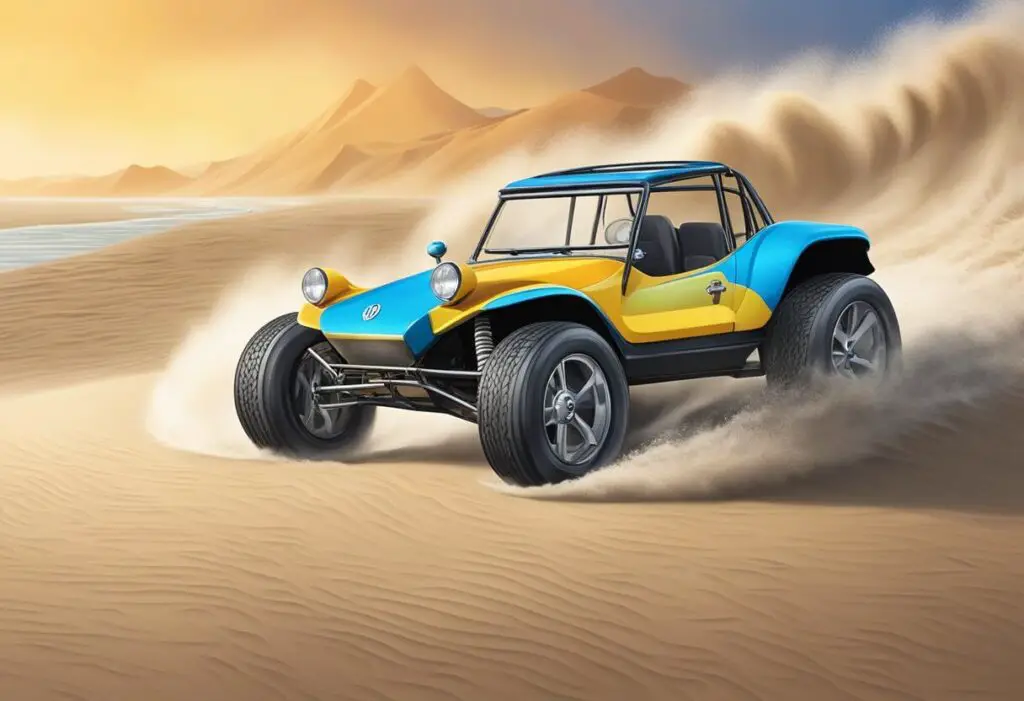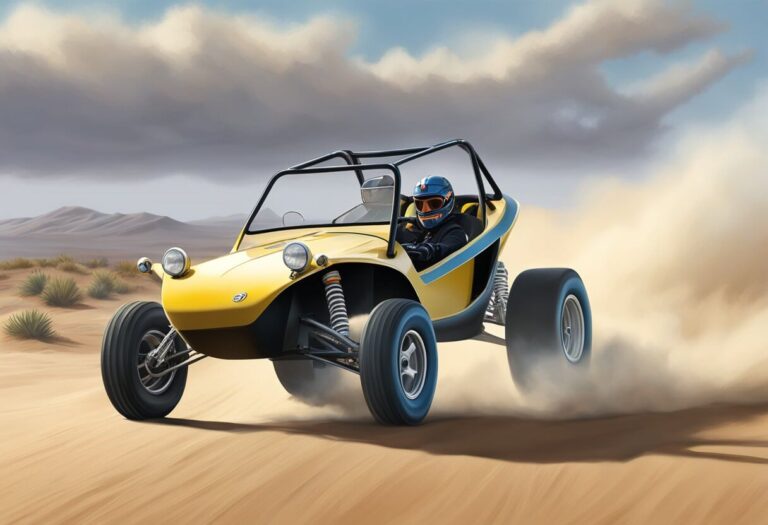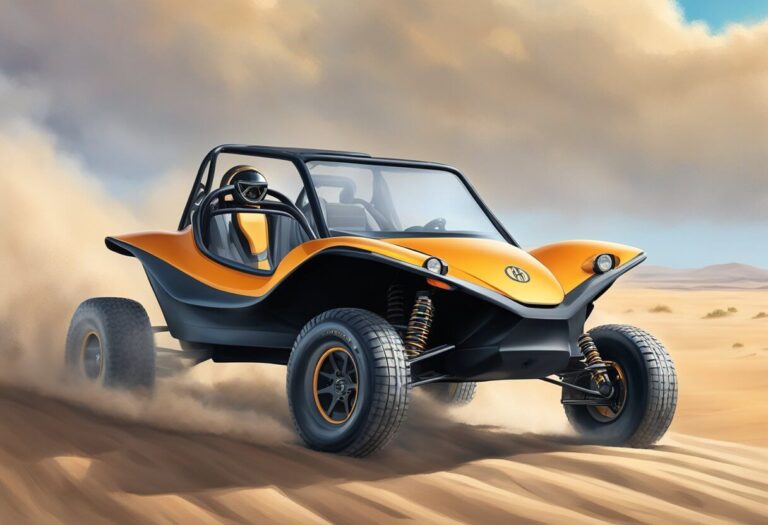Volkswagen Manx Dune Buggy: A Classic Beach Cruiser

The Volkswagen Manx Dune Buggy is a unique vehicle that has captured the hearts of many off-road enthusiasts around the world. The Manx Dune Buggy was designed by Bruce Meyers in 1964 and was based on the Volkswagen Beetle chassis. The Manx Dune Buggy quickly became popular due to its lightweight design, off-road capabilities, and customizable features.
The Manx Dune Buggy has a rich history that spans over six decades. The vehicle was initially designed for desert racing but quickly became a popular recreational vehicle due to its unique design and off-road capabilities. The Manx Dune Buggy has been featured in movies, set record times at the Baja 1000, and even managed to terrorize the streets of Hollywood. Today, the Manx Dune Buggy has become a cultural icon and is recognized worldwide as a symbol of fun, freedom, and adventure.
Key Takeaways
- The Volkswagen Manx Dune Buggy was designed by Bruce Meyers in 1964 and was based on the Volkswagen Beetle chassis.
- The Manx Dune Buggy quickly became popular due to its lightweight design, off-road capabilities, and customizable features.
- Today, the Manx Dune Buggy has become a cultural icon and is recognized worldwide as a symbol of fun, freedom, and adventure.
History of the Manx Dune Buggy

Origin and Development
The Manx Dune Buggy is a lightweight, open-top car designed for off-road use. It was first created in the 1964s by Bruce Meyers, a California-based boat builder and surfer. Meyers was inspired by the off-road vehicles he saw on the beaches and dunes of Southern California and decided to create his own version.
Meyers wanted to create a vehicle that was simple, lightweight, and affordable. He started with a shortened VW Beetle chassis and added a fiberglass body. The result was a car that was not only lightweight and easy to handle but also had a unique and stylish look.
The Manx Dune Buggy quickly became popular with off-road enthusiasts and was used for racing, as well as recreational purposes. Its success led to the creation of many other dune buggy designs, but the Manx remained the most popular and iconic.
Bruce Meyers and His Impact
Bruce Meyers was not only the creator of the Manx Dune Buggy but also a pioneer in the off-road vehicle industry. His design was not only affordable and easy to build but also had a unique and stylish look that captured the spirit of the 1960s.
Meyers’ impact on the off-road vehicle industry was significant. He inspired many others to create their own dune buggy designs and helped to popularize off-road racing. His legacy continues to this day, with many people still using and enjoying the Manx Dune Buggy.
Meyers passed away in 2021 at the age of 94. However, his impact on the off-road vehicle industry will be felt for many years to come.
Design and Features
Body and Chassis
The Volkswagen Manx Dune Buggy is a classic vehicle that has been popular for over 60 years. The body and chassis of the Manx Dune Buggy are made of fiberglass, which makes them lightweight and durable. The fiberglass body is mounted on a shortened Volkswagen Beetle chassis, which gives the car a low center of gravity and excellent handling. The Manx Dune Buggy has a sleek and aerodynamic design, with a rounded front end and a flat rear deck. The car is available in a variety of colors and finishes, including metallic and pearl paints.
Engine and Performance
The Manx Dune Buggy is powered by a Volkswagen air-cooled engine, which provides reliable and efficient performance. The engine is mounted in the rear of the car, which helps to distribute weight evenly and improve handling.The Manx Dune Buggy is available with a variety of engine options, ranging from a 1.6-liter four-cylinder engine to a 2.5-liter five-cylinder engine.
Customization Options
One of the most appealing features of the Manx Dune Buggy is its customizable design. The car is available with a wide range of options, including different paint colors, interior materials, and performance upgrades. Owners can choose from a variety of suspension systems, wheels, tires, and brakes to customize the car’s handling and performance. The Manx Dune Buggy can also be fitted with a variety of accessories, including roll bars, skid plates, and off-road lights, to enhance its off-road capabilities. With so many customization options available, the Manx Dune Buggy is a versatile and customizable vehicle that can be tailored to suit the needs and preferences of its owner.
Cultural Significance
The Volkswagen Manx Dune Buggy has had a significant impact on both motorsports and pop culture.
In Motorsports
The Manx Dune Buggy was initially designed for off-road racing, and it quickly gained popularity due to its lightweight construction and maneuverability. The vehicle’s success in off-road racing led to the creation of the Baja 1000, an annual off-road race that has become one of the most prestigious and challenging races in the world. The Manx Dune Buggy has been a staple of the Baja 1000 since its inception, and it continues to be a popular choice for off-road racing enthusiasts.
In Pop Culture
The Manx Dune Buggy has also had a significant impact on pop culture. The vehicle’s unique design and association with the Southern California beach culture of the 1960s and 1970s made it an instant icon. The Manx Dune Buggy has been featured in numerous films and television shows, including “The Love Bug,” “The Beverly Hillbillies,” and “Magnum, P.I.” The vehicle has also been referenced in popular music, with artists such as The Beach Boys and Jan and Dean singing about the Manx Dune Buggy in their songs.
The Manx Dune Buggy’s influence on pop culture can still be seen today, with the vehicle continuing to be a popular choice for car enthusiasts and collectors. The Manx Dune Buggy’s unique design and association with the Southern California beach culture of the 1960s and 1970s make it an enduring icon of American automotive history.
Buying a Volkswagen Manx Dune Buggy
When it comes to buying a Volkswagen Manx Dune Buggy, there are a few things to consider before making a purchase. This section will cover the main factors that should be taken into account when buying one of these vehicles.
New vs. Used
One of the first decisions to make when buying a Volkswagen Manx Dune Buggy is whether to buy new or used. Buying a new buggy can be a great option for those who want the latest features and technology. However, it is important to note that buying a new buggy can be more expensive than buying a used one.
On the other hand, buying a used Volkswagen Manx Dune Buggy can be a good option for those who are on a budget. Used buggies can be found at a lower price, and they may still be in good condition if they have been well-maintained.
Price Range and Affordability
The price range for a Volkswagen Manx Dune Buggy can vary depending on the make, model, and condition of the vehicle. New buggies can range from $10,000 to $30,000, while used buggies can range from $5,000 to $15,000.
Consider affordability when buying a Volkswagen Manx Dune Buggy. Take into account your budget and financial situation. Research and compare prices from different sources to find the best deal.
Inspection and Maintenance Tips
Before buying a Volkswagen Manx Dune Buggy, it is important to inspect the vehicle thoroughly. Buyers should check for any signs of wear and tear, such as rust, dents, or scratches. They should also check the engine, brakes, and suspension to ensure that they are in good condition.
Maintenance is also an important factor to consider when buying a Volkswagen Manx Dune Buggy. Regular maintenance can help keep the vehicle in good condition and prolong its lifespan. It is recommended to follow the manufacturer’s recommended maintenance schedule and to have the vehicle serviced by a qualified mechanic.
Ownership Experience

Community and Clubs
Owning a Volkswagen Manx Dune Buggy is not just about having a unique vehicle, it’s also about joining a community of enthusiasts. There are several clubs and organizations dedicated to the preservation and enjoyment of the Manx Dune Buggy. These clubs provide opportunities for owners to connect with each other, share information, and participate in events such as rallies and shows.
One such club is the Manx Club, which was founded in 2008 and has members from around the world. The club offers a variety of resources and benefits to its members, including a quarterly magazine, technical support, and access to a network of Manx Dune Buggy enthusiasts.
Driving and Handling
Driving a Manx Dune Buggy is a unique experience that can be both exhilarating and challenging. The vehicle’s lightweight design and rear-wheel drive make it nimble and responsive, but also require a certain level of skill to handle properly. The buggy’s high center of gravity and lack of roll bars can also make it more prone to tipping over, especially on uneven terrain.
Despite these challenges, many owners find driving a Manx Dune Buggy to be a rewarding experience. The vehicle’s open-air design and off-road capabilities make it ideal for exploring the great outdoors and tackling tough terrain.
Common Issues and Solutions
Like any vehicle, the Manx Dune Buggy is not without its issues. Common problems include engine overheating, electrical issues, and rust. However, many of these issues can be easily addressed with proper maintenance and care.
Regular oil changes, tune-ups, and inspections can help prevent many common issues. Owners should also be sure to keep their buggy clean and dry, especially after driving in wet or muddy conditions. Rust can be prevented by applying a rust inhibitor or protective coating to the vehicle’s metal surfaces.
Legal and Safety Considerations
Street Legality
Before taking a Volkswagen Manx dune buggy on the road, it is essential to ensure that it is street legal. The laws regarding dune buggies vary by state and country, so it is important to research the specific regulations in the area where the buggy will be driven.
In general, a dune buggy must meet the same requirements as any other vehicle on the road. This includes having proper registration and insurance, functioning lights and turn signals, and meeting emissions standards. Additionally, the buggy must have a windshield and seat belts for all passengers.
Safety Equipment
Safety should always be a top priority when driving a dune buggy. While dune buggies are designed for off-road use, they are often driven on public roads, which can be dangerous without proper safety equipment.
First and foremost, all passengers should wear helmets to protect their heads in the event of an accident. Additionally, the buggy should be equipped with roll bars or a roll cage to prevent the passengers from being crushed in the event of a rollover.
Other safety equipment that should be considered includes fire extinguishers, first aid kits, and proper off-road tires. It is important to regularly inspect and maintain all safety equipment to ensure that it is in good working condition.
By following these legal and safety considerations, drivers can enjoy the thrill of driving a Volkswagen Manx dune buggy while also staying safe and compliant with the law.
Future and Innovations
Electric Variants
As the world moves towards electric vehicles, it’s no surprise that the Volkswagen Manx dune buggy has also been reimagined as an electric vehicle. In 2024, the Meyers Manx 2.0 Electric was introduced as an all-electric dune buggy that Volkswagen refused to build. The Meyers Manx 2.0 Electric is built on a modified VW Beetle chassis with a fiberglass body kit, making it a perfect blend of classic design and modern technology. This electric vehicle has a range of around 150-300 miles and can reach a top speed of 25 mph. With its electric powertrain, the Meyers Manx 2.0 Electric is not only eco-friendly but also delivers a thrilling driving experience.
Advancements in Design
The Meyers Manx dune buggy has always been known for its unique design, and advancements in design have continued to keep it relevant even today. The original Meyers Manx was designed in 1964 by Bruce Meyers as a go-anywhere dune buggy, becoming an “American” classic and Californian icon for its whimsical design and remarkable performance.
In recent years, the Meyers Manx has made a resurgence with an EV version and a new 2+2 body. The new 2+2 body is a four-seater version of the classic dune buggy, offering more space for passengers. The new body design also features a removable hardtop, making it an all-weather vehicle. The body is made of fiberglass, which is lightweight and durable, making it perfect for off-road adventures.
All in all, the Volkswagen Manx dune buggy has come a long way since its inception in 1964. With the introduction of the Meyers Manx 2.0 Electric and advancements in design, the dune buggy continues to be a relevant and exciting vehicle even today.




